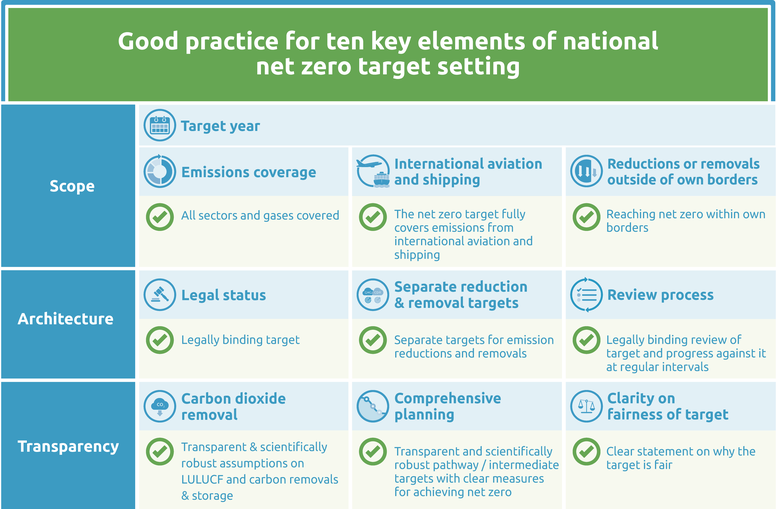Net zero targets
Summary
We evaluate the target as: Poor
Saudi Crown Prince Mohammed bin Salman announced Saudi Arabia’s net zero target for 2060 at the first Saudi Green Initiative Forum in October 2021 (Kingdom of Saudi Arabia, 2021d). However, the target has yet to be enshrined in law or in a policy document. As of October 2023, Saudi Arabia has not submitted a long-term strategy to the UNFCCC.
Since its initial announcement in 2021, the Saudi government has not provided any further detailed information on scope, target architecture, or transparency. Saudi Arabia has not yet provided any clear emissions reduction pathway to net zero (Kingdom of Saudi Arabia, 2021a). The target’s emission coverage remains unclear with the CAT currently assuming that only CO2 emissions are being covered, based on scarce available information.
Saudi Arabia intends to reach its net zero target through the Circular Carbon Economy approach, which relies on the use of CCS. The national oil company Saudi Aramco has committed to reaching net zero operational emissions in 2050. However, the vast majority of oil and gas emissions comes from the combustion of fossil fuels, not their production. Saudi Arabia and Aramco’s net zero targets do not take into account scope 3 emissions resulting from oil and gas exports. They also do not consider the economic risks associated with a continued reliance on fossil fuels exports in a net zero world.
CAT analysis of net zero target
Scope
- Target year – Saudi Arabia aims to reach net zero by 2060.
- Emissions coverage – Saudi Arabia provides no explicit information on the sectors and gases covered by the net zero target (Kingdom of Saudi Arabia, 2021d), but mainly focuses on its Carbon Circular Economy approach in explaining how it intends to meet the target. For this reason, the CAT currently assumes Saudi Arabia’s target currently only covers CO2 emissions.
- International aviation and shipping – Saudi Arabia provides no information on its intention to cover international aviation and shipping.
- Reductions or removals outside of own borders – The government recently announced the launch of a carbon crediting scheme in early 2024, which will supposedly enable companies to offset their emissions by buying carbon credits compliant with Article 6 of the Paris Agreement (Carbon-Pulse, 2023). Despite the apparent focus on companies procuring credits, Saudi Arabia appears to plan to also use the credits to meet part of its climate pledge, including its 2060 net zero target. It is unclear how this could work in practice based on the information published to date in a manner that avoids more than one entity claiming rights to the same emission reductions – an outcome which would undermine the integrity of the credits and potentially lead to an overall rise in emissions.
Target architecture
- Legal status – Saudi Crown Prince Mohammed bin Salman announced Saudi Arabia’s net zero target at the first Saudi Green Initiative Forum (Kingdom of Saudi Arabia, 2021d). Saudi Arabia has not submitted a Long-Term Strategy (LTS) to the UNFCCC as of October 2023.
- Separate reduction & removal targets – Saudi Arabia provides no information on its intention to communicate separate emission reduction and removal targets.
- Review process – Saudi Arabia provides no information on its intention to establish a review cycle for its net zero and intermediate targets.
Transparency
- Carbon dioxide removal – Saudi Arabia provides no information on its intention to communicate transparent assumptions on carbon dioxide removals.
- Comprehensive planning – Saudi Arabia provides no comprehensive planning on how it aims to achieve its net zero by 2060. It has not communicated underlying pathways, interim targets or detailed measures to meet the 2060 target. Saudi Crown Prince Mohammed bin Salman stated that Saudi Arabia relies on the Circular Carbon Economy approach to meet its net zero target and makes no reference to emissions from oil and gas exported by Saudi Arabia (Kingdom of Saudi Arabia, 2021d). The Circular Carbon Economy approach, however, only addresses a fraction of relevant emissions from oil and gas production through carbon capture and storage technologies, but most emissions come from fuel combustion rather than oil and gas extraction and processing.
- Clarity on fairness of target – Saudi Arabia provides no information on its intention to explain the target’s fairness.
Good practice
The Climate Action Tracker has defined the following good practice for all ten key elements of net zero targets. Countries can refer to this good practice to design or enhance their net zero targets.

Further analysis
Latest publications
Stay informed
Subscribe to our newsletter






